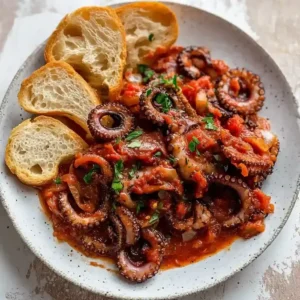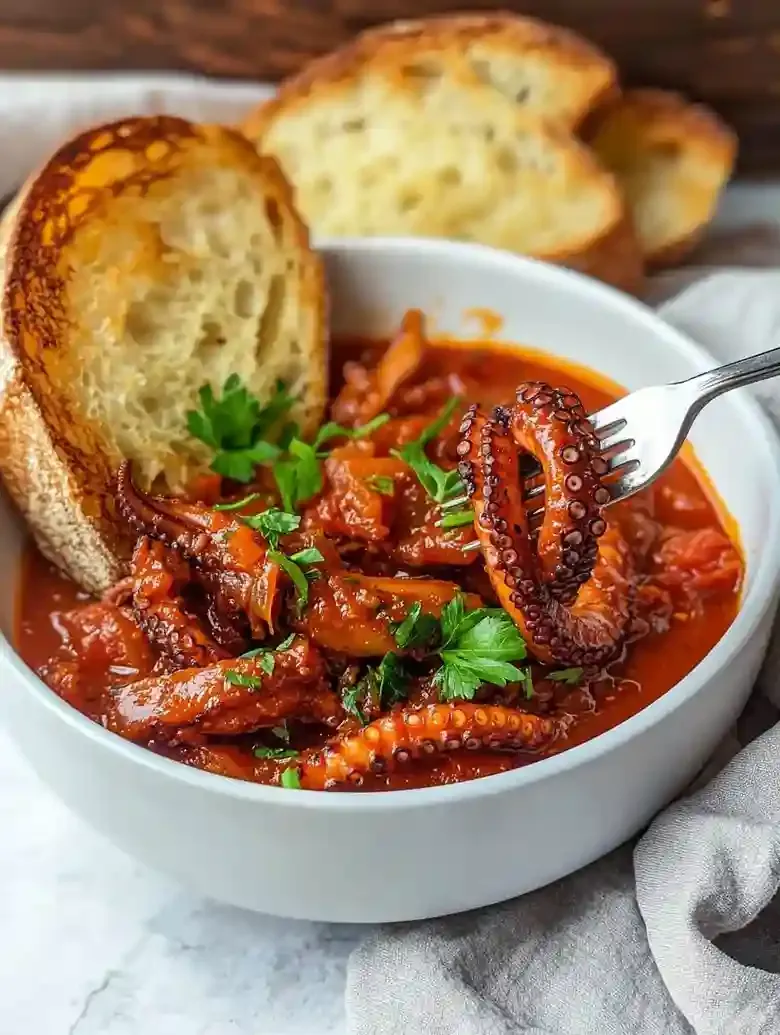If you’re curious about making polipetti in purgatorio, you’re in for a treat! This Italian dish is all about tender baby octopus simmered in a rich tomato sauce, giving it that classic seafood flavor.
This recipe addresses the challenges of achieving tenderness in octopus and enhances overall flavor while providing a cultural context for appreciation.

I know cooking octopus can feel daunting, especially when it comes to cleaning those little guys. It took me a few tries to figure out the best way to clean baby octopus without losing my patience. Trust me, this recipe makes it easier, so you can enjoy the dish without stressing out.
What really works here is the balance between sautéing the octopus until it’s just right and letting it soak in the wonderful tomato sauce. After about an hour, you can serve this dish nice and warm with crusty bread or over pasta for a comforting meal.
If you want another great seafood option, check out my Fig and Prosciutto Pizza.
Table of contents
Dietary Considerations
- This recipe is gluten-free as it contains no wheat, barley, or rye ingredients according to the listed items.
- The recipe is dairy-free because it does not include milk, cheese, or any dairy products in the ingredients.
- This recipe is not vegan because it contains polpo, which is derived from octopus, an animal product.
- The recipe is not vegetarian due to the use of polpo, which is seafood and excluded from vegetarian diets.
- The recipe is suitable for keto and low-carb diets as it focuses on protein and fat with minimal carbohydrates from vegetables.
Why You Will Love This Recipe
- Rich Flavor Profile The combination of baby octopuses and peeled tomatoes creates a savory sauce that’s comforting and robust. The natural sweetness of the tomatoes complements the tender, slightly briny flavor of the polipetti.
- Impressive Texture The slow-cooking process allows the octopuses to become wonderfully tender while maintaining a slight bite. This mix of textures makes each bite satisfying and enjoyable.
- Memory-Making Dish Whipping up polipetti in purgatorio can transport you to the sun-drenched coasts of Italy. It’s an opportunity to connect with authentic culinary traditions, making it a meaningful experience for family and friends.
- Long-Lasting Freshness This dish can be made ahead of time and stored in the fridge, allowing the flavors to deepen. It tastes even better the next day, making it a practical option for meal planning.

How to Make Polipetti in Purgatorio
- Prep Time: 15 minutes
- Cool Time:
- Cook Time: 1 hour
- Total Time: 1 hour 15 minutes
- Yield: 4 servings 1x
- Category: Main Course
- Method: Sautéing and Simmering
- Cuisine: Italian
- Diet: Gluten Free
Description
Traditional Italian dish featuring baby octopuses simmered in a rich tomato sauce with aromatic herbs and spices.
Ingredients
- 1 kg (2.2 lbs) baby octopuses (polipetti), cleaned by removing central beak, eyes, and innards
- 300 g (10.5 oz) peeled tomatoes (pomodori pelati), roughly chopped
- 4–5 tablespoons (60–75 ml) extra virgin olive oil (olio extravergine di oliva)
- 2 medium white onions (cipolle bianche), thinly sliced
- 1–2 hot chili peppers (peperoncini piccanti), chopped
- Salt, to taste
- Pepper, to taste (freshly ground)
- Fresh parsley (prezzemolo fresco), to taste, chopped for garnish
Instructions
- Step 1: Thoroughly clean the baby octopuses by removing the central beak, eyes, and the innards inside the head. Rinse them carefully under cold running water, making sure to wash away any grit. Let them drain well before cooking.

- Step 2: Place a large saucepan over medium heat. Add 4–5 tablespoons (60–75 ml) of extra virgin olive oil. Once heated, add the chopped chili peppers and thinly sliced white onions. Cook slowly, stirring occasionally, until the onions become soft and slightly golden in color. This may take around 10–15 minutes.

- Step 3: Add the cleaned baby octopuses whole to the sautéed aromatics. Stir occasionally while cooking until the octopus begins to release its juices. This process will change their texture and color, and typically takes about 10–15 minutes.

- Step 4: Add the roughly chopped peeled tomatoes to the saucepan. Season with salt to taste and add a fresh grind of pepper. Stir to combine, then cover the pan with a lid. Reduce the heat to maintain a gentle simmer for about 45–50 minutes. The sauce will develop a rich aroma and flavors will meld.

- Step 5: After simmering, taste the sauce and adjust the seasoning with additional salt and pepper as needed to balance the flavor without overpowering the octopus.

- Step 6: Before serving, sprinkle fresh chopped parsley over the dish. This will add color and a fresh herbaceous note to the final presentation.

Notes
- Room Temperature: Store in an airtight container up to 1 day. Keep away from heat and direct sunlight.
- Refrigeration: Place in an airtight container in the refrigerator for up to 3 days. Reheat gently over low heat before serving.
- Freezing: Wrap tightly in plastic wrap or aluminum foil, then store in a freezer-safe container for up to 2 months. Thaw in the refrigerator overnight before reheating.
- If baby octopuses are not tender after simmering, extend cooking time by an additional 15 minutes until fully cooked through.
- If the sauce becomes too thick, add 50 ml (about 3 tablespoons) of water while stirring continuously to smooth the consistency.
- When octopuses do not release enough juices, cook uncovered on medium heat for 10 minutes to allow evaporation.
- For a more intense flavor, simmer the dish for at least 30 minutes after adding tomatoes to deepen the infusion.
- If the dish tastes bland, add an extra pinch of salt and freshly ground pepper right before serving.
Nutrition
- Serving Size: 1 serving
- Calories: 350
- Sugar: 1g
- Sodium: 600mg
- Fat: 20g
- Saturated Fat: 7g
- Unsaturated Fat: 10g
- Trans Fat: 0g
- Carbohydrates: 15g
- Fiber: 1g
- Protein: 30g
- Cholesterol: 90mg

Ingredient Notes
- Polpo: Look for fresh octopus with firm flesh and vibrant color. Frozen can work too, but fresh offers better texture and flavor.
- Olive oil: Use high-quality extra virgin olive oil for depth of flavor. It enriches the dish and helps sauté the ingredients evenly.
- Garlic: Choose fresh garlic, as it adds a punch of flavor. Avoid pre-minced; it loses freshness and can taste harsh.
- Onion: A sweet yellow onion works best for balancing the dish’s richness. Make sure it’s firm and has no soft spots.
- Tomatoes: Opt for good-quality canned San Marzano tomatoes for a rich sauce. Fresh ripe tomatoes are also excellent during peak season.
- Red pepper flakes: Add crushed red pepper flakes for a hint of heat. Adjust based on your spice preference; a little goes a long way!
- Parsley: Fresh parsley brightens the flavors and adds a splash of color. Choose vibrant green leaves with no wilting.
Recipe Tips
- If baby octopuses aren’t tender, simmer them in the sauce for an additional 15 minutes until fully cooked through.
- When your sauce is too thick, add 50 ml of water while stirring continuously for a smoother consistency.
- If the octopuses aren’t releasing enough juice, cook them uncovered for 10 minutes on medium heat to let it evaporate.
- For a stronger flavor, let everything simmer for at least 30 minutes after adding the tomatoes for better infusion.
- If the dish turns out bland, taste and adjust with an extra pinch of salt and a grind of fresh pepper just before serving.
Serving Suggestions
Serve with crusty gluten-free bread or a light arugula salad. Include lemony zucchini noodles or grilled seasonal vegetables on the side.
Use to make seafood-stuffed peppers or serve alongside polenta. Add to a mixed seafood stew or pasta dish for added flavor.
Top with fresh basil or a squeeze of lemon juice. Drizzle with a homemade olive oil and garlic sauce for extra depth.
Recipe variations
- You can use small squid instead of polipetti for a similar texture and flavor. This substitution keeps the dish seafood-focused while slightly changing the bite.
- Add 1 teaspoon of minced garlic and 2 tablespoons of capers along with the chili and onions to introduce a briny, aromatic twist without altering the base sauce dramatically.
- Either canned peeled tomatoes or fresh chopped tomatoes can be used. If using fresh, simmer a bit longer to break them down and develop the sauce fully.
- If preparing for a larger group, you can double the polipetti to 2 kg and increase the olive oil and tomatoes proportionally, maintaining the same cooking times and seasoning levels.
Save This Recipe!
How to Store?
To keep your polipetti in purgatorio fresh and delicious, follow these storage tips:
Room Temperature: Store in an airtight container at room temperature up to 1 day. Avoid exposure to heat or direct sunlight.
Refrigeration: Place in an airtight container in the refrigerator up to 3 days. Reheat gently on low heat before serving.
Freezing: Wrap tightly in plastic wrap or aluminum foil, then place in a freezer container up to 2 months. Thaw in the refrigerator overnight.
Other Recipes You’ll Love
- Toasted Coconut Marshmallows
- Puff Pastry Apple Rosettes
- Rhubarb and Strawberry Tart Recipe
- Chocolate Peanut Clusters
If you enjoyed this Polipetti in Purgatorio or any other recipe on my blog, please leave a ⭐ star rating and let me know how it went in the comments below. I appreciate taking time to read about this recipe, thank you!
